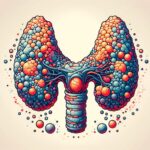Hashimotos Disease and AFFF: Challenges in Proving Liability
We acknowledge the challenges in connecting Hashimoto's disease to AFFF exposure, arising from the need to reconcile legal requirements with scientific evidence. Affected individuals must carefully document their exposure, support their claims with strong medical proof, and often depend on expert testimony to establish the vital link between AFFF contact and their thyroid condition. The struggle is demanding, requiring a thorough understanding of both the statutory frameworks and the related health implications. Additionally, maneuvering statutes of limitations adds another layer of complexity. Adequate compensation addresses extensive medical expenses and impacts on quality of life, underscoring the importance of the situation. Continuing on will reveal further insights into handling these legal waters.
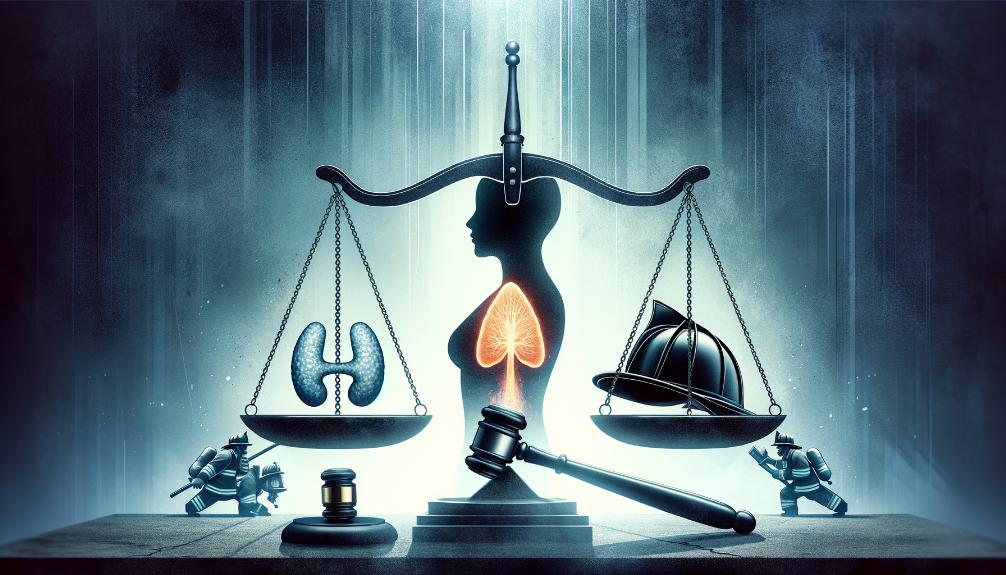
Key Takeaways
- Establishing direct causation between AFFF exposure and Hashimoto's disease requires solid scientific evidence and expert testimony.
- Victims must demonstrate a clear exposure history to AFFF, linking it to their thyroid condition.
- The persistence and accumulation of PFAS chemicals in the body complicate proving specific health outcomes like Hashimoto's.
- Statutes of limitations vary by state, challenging timely legal action and evidence gathering.
- Legal complexities arise in distinguishing AFFF exposure effects from other potential causes of Hashimoto's disease.
AFFF and Thyroid Disease Link
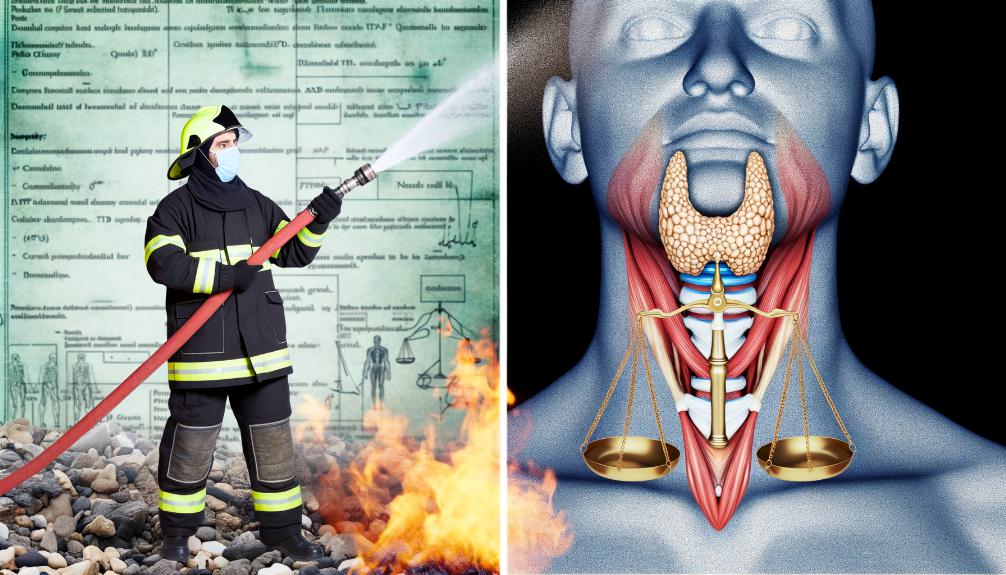
The connection between AFFF exposure and thyroid diseases like Hashimoto's is increasingly recognized as an important public health concern. We're learning more every day about how AFFF, a foam used extensively in firefighting, introduces PFAS chemicals into our bodies. These chemicals are potent endocrine disruptors, wreaking havoc on our thyroid hormone system. The science is clear: exposure to AFFF is linked to an increased risk of thyroid diseases, including the autoimmune condition Hashimoto's.
For those unfamiliar, PFAS chemicals found in AFFF interfere with the enzymes essential for thyroid hormone synthesis. This interference can lead to thyroid diseases due to the disruption of normal hormonal balances. It's not just a minor inconvenience; these diseases, such as hypothyroidism, can degrade the quality of life for those affected. We're talking about serious, long-term health issues that nobody should have to face alone.
Understanding this link is more than an academic exercise. It's about acknowledging the struggles of victims, many of whom are firefighters who've been exposed to AFFF in the line of duty. They're facing an uphill battle not just against their health conditions but also in seeking recognition and compensation for their suffering. The reality of thyroid disease due to AFFF exposure, specifically conditions like Hashimoto's, illustrates the broader issue of how occupational hazards can lead to important, life-altering diseases. As we navigate these challenges, it's important to keep the focus on supporting the affected individuals and advocating for their rights.
Legal Pathways for Claimants
Traversing the legal terrain, it's essential for claimants to comprehend the pathways available for seeking compensation due to Hashimoto's disease caused by AFFF exposure. Specialized legal representation is not just beneficial; it's a prerequisite in *maneuvering* the complexities of these cases. With settlements ranging between $300,000 to $450,000, reflecting the severity of the condition, obtaining the right legal counsel *guarantees* that the compensation for affected individuals is not only pursued but maximized.
Our collective journey in securing justice involves compiling detailed evidence, including documentation of AFFF contact history. This evidence, alongside expert medical testimonies, plays a pivotal role in establishing the link between AFFF exposure and Hashimoto's disease. It is through this meticulous gathering of proof that we can begin to establish liability against those responsible for AFFF distribution and use.
Moreover, understanding the statutes of limitation is *vital* in these cases. Our legal team is adept at *managing* these time constraints, *assuring* that claims are filed within the permissible period. This knowledge safeguards claimants from being barred due to procedural oversights.
Compensation aims not only to cover medical costs but also to reflect the overall impact on the quality of life for claimants. Hence, it's our mission to provide the affected individuals with the best chance at securing the compensation they rightfully deserve. Through specialized legal representation, we're committed to overcoming the challenges of establishing liability and *navigating* the legal pathways to justice for those impacted by Hashimoto's disease due to AFFF exposure.
Filing AFFF Lawsuits

Having explored the legal pathways for claimants, it's now time to focus on the specifics of filing AFFF lawsuits. When we're considering the steps to take, it's vital to underscore that detailed documentation of one's exposure history and medical records forms the backbone of any successful claim. These cases aren't straightforward; they demand specialized legal representation to navigate the complexities of proving liability, especially in AFFF cases linked to Hashimotos disease.
Our journey into the legal fray involves tackling claims of negligence, product liability, and violations of environmental law against the manufacturers. It's not just about presenting our case; it's about substantiating it with irrefutable evidence. This is where expert witnesses come into play, lending their scientific expertise to provide evidence and testimonies critical for establishing liability.
The legal process for filing these lawsuits is intricate, involving court proceedings that demand rigorous evidence collection and compensation negotiations. It's a path we're prepared to tread, equipped with our medical records and a detailed account of our exposure history. Our aim? To seek justice and compensation for the victims of Hashimotos disease affected by AFFF exposure.
Navigating this terrain requires more than just legal knowledge; it requires an understanding of the intersection between legal and medical realms, and an appreciation for the role of environmental law in these cases. With the right team of lawyers and expert witnesses, we're ready to face the challenges ahead, committed to securing the compensation our clients rightfully deserve.
Compensation Eligibility Criteria
To successfully navigate the complex landscape of AFFF lawsuit compensation, we'll need to thoroughly understand the eligibility criteria, which hinges on solid evidence linking Hashimotos disease to AFFF exposure. It's clear that detailed evidence plays a critical role in determining compensation eligibility. This involves not just any evidence, but expert medical opinions and scientific evidence that directly support claims of Hashimotos disease resulting from AFFF exposure.
Furthermore, documented exposure history is indispensable. We're talking about concrete details concerning work environments and the duration of PFAS contact. This isn't just about proving exposure but demonstrating a clear link between the exposure and the onset of Hashimotos disease. Such documentation becomes the backbone of a claim, providing a narrative that expert testimonies can support.
Legal assistance also emerges as a crucial element in maneuvering the intricacies of compensation eligibility. Understanding statutes of limitation is essential, as these laws can vary greatly, affecting the viability of a claim. As a result, securing legal guidance early on can make a significant difference in the process.
Lastly, meeting specific criteria is key to achieving favorable outcomes. It's not just about filing a claim; it's about ensuring that every piece of evidence, every documented exposure, aligns with the criteria set forth for compensation. This meticulous approach to meeting specific criteria is what ultimately steers claimants towards favorable outcomes.
Scientific Evidence Overview
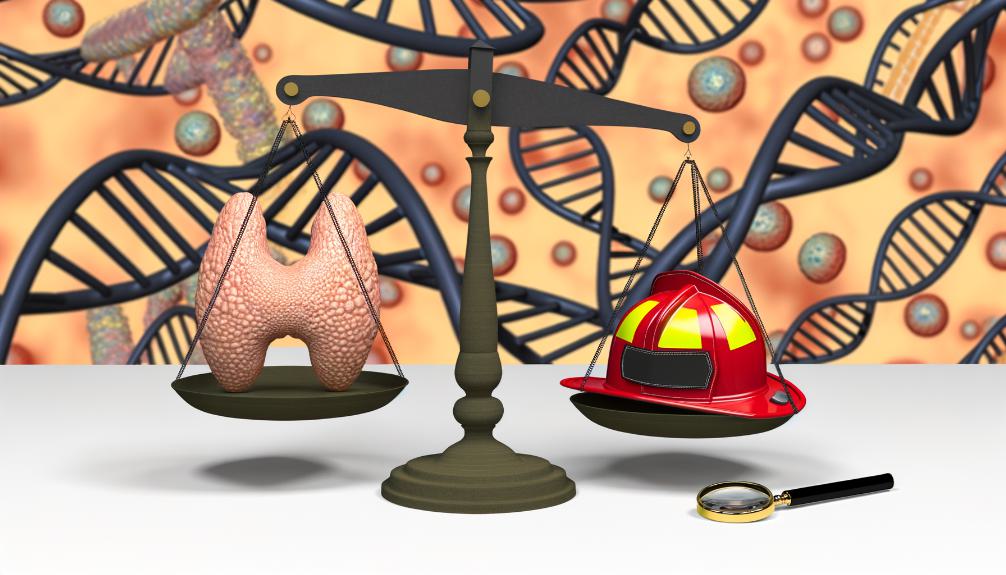
We'll now examine the compelling scientific evidence that connects AFFF exposure to Hashimoto's disease, highlighting the key points. Our focus will be on how chemicals in AFFF are linked to Hashimoto's, the methodologies researchers use to explore this connection, and the legal challenges that arise when attempting to prove liability. This overview is essential for understanding the complexities involved in establishing causation in legal claims.
Linking Chemicals to Hashimotos
In our investigation of the connection between AFFF exposure and Hashimoto's disease, it is crucial to explore the scientific evidence that directly links PFAS chemicals to autoimmune thyroid conditions. Research underscores that PFAS chemicals in AFFF disrupt thyroid hormone functioning, a critical pathway leading to Hashimoto's disease. This disruption is not incidental but a direct consequence of exposure to these chemicals, highlighting a substantial health risk for individuals. The scientific community has provided compelling evidence of the initiation of autoimmune responses from PFAS exposure, greatly increasing susceptibility to Hashimoto's. Detailed evidence and expert testimonies are indispensable in legal contexts to conclusively establish the link between AFFF exposure and Hashimoto's disease, emphasizing the necessity for rigorous scientific inquiry and legal scrutiny in these cases.
Research Methodologies Explored
Delving into the methodologies behind the research, we frequently find that the link between AFFF exposure and Hashimoto's disease relies on a blend of epidemiological studies, laboratory experiments, and clinical observations. These research methodologies illuminate how PFAS exposure can disrupt thyroid function, leading to autoimmune thyroid conditions such as Hashimoto's disease. The scientific evidence gathered through these approaches is crucial in establishing a causal relationship between AFFF exposure and the onset of Hashimoto's. By understanding the specific mechanisms by which PFAS chemicals impact the thyroid, we're better equipped to demonstrate liability in cases of Hashimoto's disease related to AFFF exposure. This holistic approach, combining various research methodologies, provides a robust foundation for proving the connection between PFAS exposure and autoimmune thyroid conditions.
Legal Hurdles Identified
Traversing the legal landscape, it's evident that the scientific evidence linking PFAS in AFFF to Hashimoto's disease is essential for proving liability. It's not just about showing PFAS exposure; it's about detailing how this exposure impacts thyroid function and leads to Hashimoto's disease. Legal claims hinge on expert medical opinions that can convincingly argue this connection. We're faced with the intricate task of understanding how PFAS disrupts thyroid hormone functioning, which is crucial for demonstrating liability. This integration of scientific evidence and expert testimonies outlines the significant legal hurdles in proving liability for Hashimoto's disease due to AFFF exposure. It's a thorough approach that requires a thorough examination into both scientific research and legal expertise.
Hashimotos Disease Pathogenesis

We're now turning our attention to the complex interplay of autoimmune response mechanisms along with genetic and environmental factors in Hashimoto's disease pathogenesis. It's important to understand how PFAS chemicals in AFFF may disrupt thyroid function and contribute to the disease, shedding light on possible legal liabilities. This exploration is essential in unraveling the intricate connections and advancing the discussion on proving liability for Hashimoto's disease stemming from AFFF exposure.
Autoimmune Response Mechanism
At the core of Hashimoto's disease lies an autoimmune response where our body mistakenly attacks its own thyroid gland, leading to significant health impacts. This autoimmune response mechanism is pivotal to understanding Hashimoto's disease pathogenesis. Our immune system, designed to protect us, malfunctions in this condition, targeting thyroid proteins and impacting hormone production. This leads to thyroid dysfunction, characterized by symptoms like fatigue, weight gain, and cold sensitivity. Importantly, exposure to PFAS chemicals, present in AFFF firefighting foam, can trigger this autoimmune process, disrupting thyroid function further. Grasping the autoimmune mechanism in Hashimoto's disease is essential for establishing liability in AFFF exposure cases, paving the way for seeking compensation.
Genetic and Environmental Factors
Understanding Hashimoto's disease's pathogenesis requires examining how genetic predisposition and environmental factors, like exposure to PFAS-laden AFFF, interplay to trigger the autoimmune response. Genetic factors play a key role in influencing the immune system's reactivity to thyroid antigens, making some individuals more susceptible to Hashimoto's disease. This susceptibility becomes particularly concerning when coupled with environmental triggers such as PFAS chemicals found in AFFF, which are known to disrupt thyroid function and potentially contribute to autoimmune thyroid conditions. The essential interplay between one's genetic makeup and exposure to environmental toxins like PFAS underscores the complexity of pinpointing the genesis of Hashimoto's disease in individuals exposed to AFFF. Research further supports that this combination of genetic predisposition and environmental triggers can initiate an autoimmune response targeting the thyroid gland, emphasizing the multifaceted nature of Hashimoto's disease pathogenesis.
AFFF Exposure Risks
Exposure to AFFF carries substantial health risks due to the presence of toxic PFAS chemicals. These substances are well-known for their persistence in the environment and their ability to accumulate in human bodies, leading to a multitude of health issues. Among the most concerning effects of PFAS exposure is its potential to disrupt thyroid hormone synthesis. This disruption can pave the way for thyroid diseases, including Hashimoto's disease, a condition where the immune system turns against the body's own thyroid gland.
Our understanding of these risks is particularly relevant to individuals in the military and other occupations that frequently use AFFF for fire suppression. These individuals are at a heightened risk of direct contact with these toxic chemicals. Additionally, the leaching of PFAS into soil and water supplies poses a broader public health risk, extending beyond those directly handling the substances.
The health risks associated with AFFF exposure are not limited to thyroid dysfunction. Research has linked PFAS exposure to a range of serious conditions, including developmental effects in children, liver damage, and even cancer. These findings underscore the importance of recognizing the full spectrum of health risks posed by these toxic substances.
Recent studies bolster claims that exposure to PFAS through AFFF can contribute significantly to thyroid dysfunction. This emerging evidence highlights the need for a deeper understanding of the mechanisms through which these chemicals interfere with thyroid hormone synthesis and the broader implications for public health. As we continue to explore the connection between PFAS exposure and disease, it's critical to keep these risks at the forefront of our discussions.
Linking Evidence: Hashimotos & AFFF

How can we establish a definitive link between AFFF exposure and the onset of Hashimoto's disease? It's a question we've grappled with, especially considering the complexity of proving liability in such cases. The key lies within the PFAS chemicals found in AFFF, known for their disruption of thyroid hormone production, which is critical to the development of Hashimoto's disease. This disruption is not merely a hypothesis; scientific evidence supports the connection, pointing to a significant link between AFFF exposure and the emergence of thyroid disorders.
To solidify this link, detailed evidence and expert testimonies are paramount. These experts explore the mechanisms by which PFAS contamination can lead to autoimmune thyroid conditions, including Hashimoto's. Their insights are important, as they provide the scientific backing needed to understand the health risks associated with AFFF exposure. By drawing on studies and research findings, they can effectively illustrate how PFAS chemicals trigger the disruption necessary to precipitate Hashimoto's disease.
Understanding this link is essential not just for those directly affected by these health struggles but also for legal professionals dealing with the challenges of proving liability. The complexities of such cases require a thorough examination of the intricacies of how AFFF exposure translates to thyroid disorders. Through a combination of scientific research and expert testimonies, we're better equipped to demonstrate the causative relationship between AFFF exposure and the onset of Hashimoto's disease, thereby laying the groundwork for holding responsible parties accountable.
Compensation Expectations
We're now shifting our focus to the expectations surrounding compensation for those impacted by Hashimoto's due to AFFF exposure. It's imperative we grasp the process of calculating damage estimates, acknowledge the legal hurdles faced, and recognize the challenges in payment distribution. These aspects are vital for victims seeking fair compensation and for legal professionals guiding them through this intricate journey.
Calculating Damage Estimates
Calculating damage estimates for Hashimoto's claims due to AFFF exposure involves a complex assessment of medical costs, suffering, and the overall impact on an individual's quality of life. As we're gearing up for compensation negotiations set to commence in 2024, it's essential to understand that these damage estimates hinge on several factors. The quality of medical documentation, the duration of PFAS exposure, and the tangible impact on health and daily living play pivotal roles. Our specialized legal representation is preparing to leverage expert testimonies to underscore the severity of Hashimoto's claims. Fair compensation, reflecting both the financial and emotional toll, is our primary goal. Ensuring that each case is meticulously documented and argued is paramount for achieving just outcomes for those affected by PFAS exposure through AFFF.
Legal Hurdles Faced
Traversing the legal landscape to secure compensation for Hashimoto's disease due to AFFF exposure presents numerous challenges, from establishing clear liability to negotiating fair settlements. Our compensation expectations, ranging from $300,000 to $450,000, reflect the severity of the condition and underscore the necessity for detailed documentation, expert testimonies, and solid scientific evidence. Confronting the legal hurdles of proving liability necessitates demonstrating the direct link between AFFF exposure and Hashimoto's disease. It's a complex journey, requiring specialized legal representation to navigate the intricacies of the case effectively. Our collective goal is to make certain that settlement amounts truly reflect the health impact severity and the thorough implications on an individual's quality of life, while overcoming the inherent legal hurdles.
Payment Distribution Challenges
After overcoming legal hurdles to establish liability, we now face the complex task of ensuring fair payment distribution for those affected by Hashimoto's due to AFFF exposure. The challenge lies in addressing the multifaceted impact of Hashimoto's disease, from health struggles to financial losses. Compensation distribution hinges on several factors, including the quality of medical documentation, the duration of PFAS exposure, and the caliber of legal representation. Settlements, ranging from $300,000 to $450,000, reflect the severity of the condition but underscore the necessity for specialized legal representation. Such expertise is vital in handling these challenges and securing fair compensation that truly reflects the extent of the hardships endured.
Selecting Legal Representation
Choosing the appropriate legal representation is essential when dealing with the intricacies of AFFF litigation and establishing liability for Hashimoto's disease. The right legal team becomes our ally, guiding the complexities of toxic exposure, particularly how it disrupts the thyroid hormone system through PFAS contamination. Given the specialized nature of AFFF litigation, identifying attorneys with the requisite expertise is vital. These professionals possess a deep understanding of environmental law, important for maximizing compensation and effectively establishing liability.
Our search for legal representation must prioritize those with a proven track record in handling AFFF cases. Such expertise is not merely advantageous but necessary to secure favorable outcomes in settlements. The unique challenges presented by these cases, including the intricate scientific connections between AFFF exposure and Hashimoto's disease, demand attorneys who are not only familiar with the legal landscape but also adept at maneuvering its nuances.
The importance of selecting the right legal representation cannot be overstated. Victims of AFFF exposure face substantial hurdles in proving liability. Therefore, partnering with attorneys experienced in environmental law and AFFF litigation can make a substantial difference. These professionals are equipped to overcome challenges, providing the support and guidance needed to seek compensation effectively.
In essence, our journey towards justice for Hashimoto's disease, precipitated by AFFF exposure, begins with the careful selection of legal representation. It's a critical step that can significantly influence the resolution of our claims, underscoring the value of expertise, experience, and a successful track record in this specialized field.
Proving AFFF Exposure

Having selected the right legal team, we now face the challenge of proving AFFF exposure, a task that necessitates compiling a robust array of evidence. Documenting detailed evidence of exposure history, work environments, and duration of contact with PFAS chemicals is essential. These toxic substances have been linked to a range of health issues, including the development of thyroid diseases such as Hashimoto's. The legal process in these cases is complex, requiring a deep understanding of statutes of limitation and eligibility criteria for filing claims.
Expert medical opinions and scientific evidence are pivotal in establishing the connection between AFFF exposure and Hashimoto's disease. To build a compelling case, we're gathering thorough documentation, including medical records and expert testimonies. This evidence is necessary for demonstrating the link between PFAS exposure and the health issues our clients are facing.
Navigating the legal complexities of proving AFFF exposure is a challenging task, but with the right legal assistance, we're equipped to handle it. Meeting the eligibility criteria and providing convincing evidence are key factors in achieving favorable outcomes in compensation claims related to Hashimoto's disease from AFFF exposure.
Our goal is to make sure that those exposed to these harmful substances and suffering from health consequences as a result have their day in court. By meticulously documenting exposure and establishing the link between PFAS exposure and the development of thyroid diseases, we're moving closer to holding responsible parties accountable for their actions.
Health Conditions and AFFF
We're now turning our attention to how AFFF exposure is intricately linked to Hashimoto's disease and the considerable risks this poses. We'll explore the direct impact of PFAS chemicals on thyroid health and how this connection complicates the legal landscape for those seeking justice. Our discussion will highlight the hurdles faced in proving liability, emphasizing the need for a nuanced understanding of both the medical and legal domains.
AFFF Exposure Risks
Exposure to AFFF, due to its PFAS content, is linked to serious health conditions like Hashimoto's disease, underscoring the need for awareness and action. The risk of developing thyroid issues is heightened with exposure to PFAS, as these chemicals are potent endocrine disruptors that can interfere with thyroid hormone synthesis. This interference increases the likelihood of AFFF exposure leading to thyroid diseases, including hypothyroidism, which can greatly impact individuals' quality of life. The evidence of AFFF exposure contributing to health impacts necessitates exploring legal pathways for victims seeking compensation. Especially for firefighters, who are at a heightened risk, acknowledging the connection between AFFF exposure and thyroid diseases is essential for advocating their rights and securing necessary compensation.
Hashimotos Disease Link
A significant link exists between AFFF exposure, containing PFAS chemicals, and the development of autoimmune thyroid conditions such as Hashimoto's disease. Research has uncovered that PFAS chemicals, notorious components of AFFF, disrupt thyroid hormone functioning. This disruption is not significant; it leads directly to conditions like Hashimoto's disease, marking a clear path from exposure to illness. These findings are critical for individuals who've endured health struggles due to AFFF exposure. Understanding how PFAS exposure can initiate autoimmune responses, thereby increasing susceptibility to thyroid diseases, is essential. It underscores the health struggles faced by those with Hashimoto's disease, directly linked to AFFF exposure. For affected individuals, grasping the connection between AFFF and thyroid diseases is the first step toward addressing their health complications.
Legal Hurdles Faced
Understanding the link between AFFF and thyroid diseases, such as Hashimoto's, sets the stage for the intricate legal battles victims face in proving liability. In these personal injury cases, plaintiffs must navigate through the demanding task of connecting their thyroid disease directly to AFFF exposure. This involves gathering thorough exposure history, medical records, and specific scientific evidence that PFAS chemicals in AFFF are responsible for their condition. Additionally, expert testimony becomes indispensable in bridging this gap. However, we're also up against stringent legal processes and statutes of limitation that further complicate legal action. This means we have to act swiftly and meticulously to establish liability, ensuring those affected by AFFF exposure receive the justice they deserve.
Lawsuit Deadlines and Procedures
Exploring the legal terrain, it's essential we're cognizant of the differing statutes of limitations, as they directly impact our capacity to file a claim for AFFF exposure-related Hashimoto's disease. The timelines for initiating legal action vary greatly by state, with deadlines for filing AFFF-related claims ranging from one to three years following the discovery of the condition. This variability underscores the necessity for individuals seeking compensation to act promptly.
In addressing lawsuit deadlines and procedures, it's vital we grasp that the procedural requirements for AFFF lawsuits aren't just about meeting deadlines. They involve a thorough approach that includes timely filing, meticulous gathering of evidence, and satisfying strict legal standards to establish liability for Hashimoto's disease. Legal professionals specializing in this field are pivotal in understanding the intricacies of these processes, ensuring that every step, from serving the complaint to responding to motions and attending court hearings, adheres to procedural rules.
For individuals seeking compensation for AFFF exposure and thyroid issues, the journey is filled with complexities. Adhering to the procedural requirements for AFFF lawsuits is essential in building a strong case. Our collective effort to comprehend and comply with these legal frameworks is crucial. By doing so, we not only safeguard our right to seek justice but also increase the likelihood of securing the compensation deserved for the harm endured. As we move forward, let's remain vigilant and proactive, leveraging the expertise of legal professionals specializing in this niche to guide us through the maze of legal procedures and deadlines.
Settlement Determination Factors
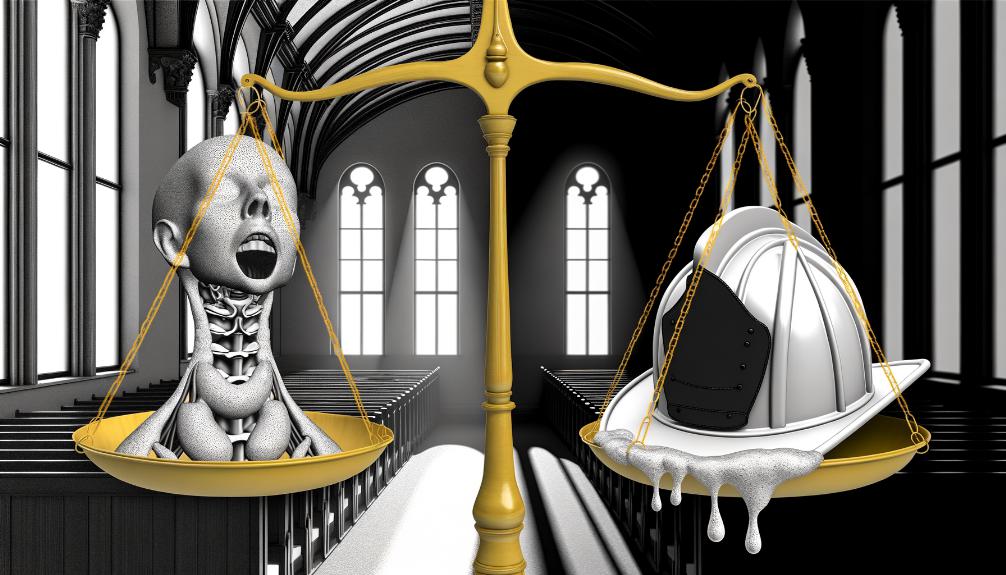
Having covered the legal procedures and deadlines, let's now focus on the factors that play a pivotal role in determining settlement amounts for Hashimoto's disease claims resulting from AFFF exposure. It's essential to understand that settlement amounts, typically ranging from $300,000 to $450,000, are influenced by several key factors. Among these, the quality of medical documentation stands out as a cornerstone for establishing the severity of the condition and its link to AFFF exposure. This documentation not only supports the claim but also underscores the necessity for fair compensation.
Moreover, the caliber of legal representation cannot be overstated. Experienced attorneys, well-versed in environmental litigation and specifically in cases related to AFFF exposure, are instrumental in navigating the complexities of such claims. They ensure that all aspects of suffering and losses are meticulously documented and presented during settlement negotiations.
Another critical factor is the duration of exposure to PFAS chemicals. Longer exposure periods typically correlate with more severe health impacts, which in turn can influence settlement amounts. Additionally, gathering comprehensive documentation of exposure history is essential for substantiating claims.
As we look towards settlement negotiations expected to commence in 2024, it's important for affected individuals to prepare by compiling all relevant information. This preparation, coupled with strong legal representation, is key to ensuring that settlements adequately reflect the multifaceted repercussions of AFFF exposure and the significant impact on individuals' quality of life. Advocating for fair compensation is not just about addressing financial losses but also acknowledging the profound personal suffering and health challenges faced by those with Hashimoto's disease.

This post has been generated by AI and was not reviewed by editors. This is Not legal advice. Please consult with an attorney.
